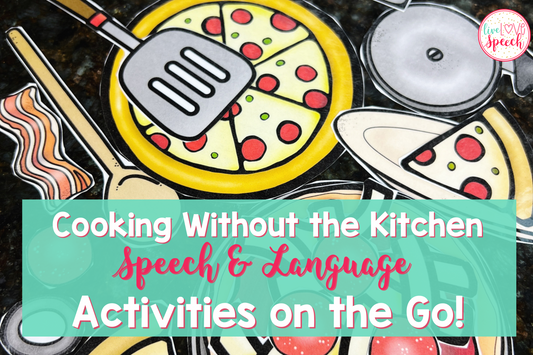
Ever look across the dinner table and spot your kids staring at their food with glum faces? Unsure if it’s something they don’t like or possibly a food sensitivity?
As a Speech-Language Pathologist (SLP), I understand that mealtime can be a complex experience for children with sensory challenges, especially those affected by food sensitivities.
Supporting parents and caregivers in fostering children’s communication and feeding skills is a passion of mine. Today, I’m here to share insights and strategies for navigating food sensitivities at the table, making it a little easier for you and them.
Understanding Food Sensitivities
Food sensitivities in children can manifest in various ways, causing confusion and concern for parents. One day your child might eagerly eat a meal, only to refuse the same dish the next, leaving you wondering what changed.
These sensitivities can make everyday meals feel like a guessing game, where the usual family favorites might suddenly become sources of discomfort for your child. Here are some examples of how they can manifest:

-
Texture Sensitivities: Some children may struggle with certain textures, finding them unpleasant or overwhelming. For instance, a child might gag at the sight of mashed potatoes or refuse to eat anything crunchy. Understanding and respecting these texture sensitivities is crucial for making mealtimes less stressful.
-
Taste Preferences: Children may have strong preferences or aversions to certain tastes or flavors. A child might love sweet foods but have an aversion to anything sour or bitter. Recognizing these preferences can help in planning meals that are both nutritious and enjoyable for the child.
-
Sensory Processing Differences: Sensory processing issues can impact how a child experiences and responds to sensory input, including food-related sensations. For example, a child with sensory processing differences might find the smell of certain foods overwhelming or be sensitive to the temperature of their meals.
Challenges of Food Sensitivities
Children with food sensitivities often face numerous challenges during mealtime, impacting both their physical health and emotional well-being. These challenges include:

- Limited Food Choices: Children may prefer a narrow range of foods and resist trying new ones, making it difficult to introduce a balanced diet. For example, a child might only eat a few select foods, such as plain pasta or bread, and refuse any new or unfamiliar dishes.
- Anxiety: Sensory issues can cause children to feel anxious or stressed about eating. This anxiety might manifest as tantrums, refusal to eat, or visible distress at the sight or smell of certain foods, making mealtime a challenging experience for both the child and the family.
- Disrupted Eating Patterns: Maintaining a balanced diet can be difficult due to food aversions or sensitivities. Children might skip meals or eat very little if they encounter foods they cannot tolerate, leading to nutritional gaps and growth concerns.
Navigating these challenges requires patience, creativity, and understanding from the parents or caretakers. By creating a supportive and accommodating mealtime environment, we can help our children manage food sensitivities more effectively, ensuring they receive the nutrition they need while minimizing stress and anxiety. Don't worry I will walk you through how to do this in the steps below!
Practical Strategies for Food Sensitivities:
With these thoughtful strategies, it is possible to create a positive and nurturing dining experience. Here are my practical approaches to help with food sensitivities:
❤️ Respect Preferences: Acknowledge and respect your child's food preferences and sensitivities without pressuring them to eat certain foods. For example, if your child prefers crunchy textures, offer a variety of crunchy vegetables like carrot sticks or apple slices instead of insisting on softer options like mashed potatoes.
❤️ Gradual Exposure: Introduce new foods gradually, incorporating preferred textures or flavors to ease the transition. If your child enjoys sweet flavors, try introducing new vegetables by pairing them with a small amount of honey or a familiar dip they like. Start with tiny portions of the new food alongside their favorites, gradually increasing the amount as they become more comfortable.
❤️ Offer Choices: Provide a variety of foods within your child's comfort zone, allowing them to make choices and feel empowered. For instance, during snack time, offer a selection of safe foods like cheese sticks, rice cakes, and fruit slices, and let your child choose what they want to eat. This approach can help reduce mealtime battles and encourage independence.
❤️ Create a Positive Environment: Make mealtime enjoyable and stress-free by minimizing distractions and fostering a calm atmosphere. Turn off the TV, put away electronic devices, and set a routine for family meals. Create a pleasant dining environment with soft background music and engaging conversation to make mealtime a positive experience.
❤️ Incorporate Play: Use playful approaches such as food-themed games or activities to desensitize and encourage exploration of new foods. For example, use a Visual Recipe where your child can help create their dinner or snack! Having pictures or visuals to illustrate each step will make it more fun, plus they get to use their imagination to create the dish. Like this Visual Recipe Ladybug Apples, which is part of my Visual Recipe Bundle which includes EVERYTHING you need to incorporate hands on learning & cooking into your own kitchen. Plus, they are no-cook making it easier to create with your littles! This can make trying new foods an enjoyable and creative activity. You can also let your child decorate their plate with the ingredients to make fun shapes or faces, turning mealtime into a fun and interactive experience.
❤️ Focus on Sensory Integration: Incorporate sensory-friendly strategies such as offering alternatives for challenging textures or incorporating familiar foods into new recipes. If your child dislikes the texture of steamed vegetables, try offering raw or lightly cooked versions instead. Blend vegetables into smoothies or incorporate them into favorite dishes like pasta or pizza to make them more palatable.
Supporting Communication Skills
Not only can you help your kids with sensitivities, but your mealtime can also be a great opportunity to support communication development in children with sensory challenges:
-
Encourage Verbalization: Prompt your child to describe their food preferences, sensations, or experiences using appropriate language. Ask questions like, "How does that taste?" or "What do you think of the texture?" to encourage them to express themselves.
-
Utilize Visual Aids: Utilize visual aids like visual recipes to facilitate communication and reduce anxiety. Visual recipes provide step-by-step instructions with images, helping your child understand what is being served and making mealtime choices more comfortably. My Visual Recipe Cards are 48 KID-FRIENDLY Recipes that come in a box, with options for dinner, snacks & dessert! Using visual support makes the mealtime experience less overwhelming and more engaging for children with sensory challenges.
-
Practice Social Skills: Engage in mealtime conversations, turn-taking, and sharing experiences related to food. Discuss topics such as favorite foods, recipes, or family traditions to create a sense of community and improve social interactions during meals.
Collaborate
If you need extra help with sensitivities, it's always a good idea to collaborate with a multidisciplinary team, including SLPs, occupational therapists, and nutritionists. This approach can provide comprehensive support for your child. These professionals can develop personalized strategies to address feeding challenges and promote positive mealtime experiences.
By leveraging the expertise of different professionals, you can ensure your child receives the tailored support they need to thrive.
Conclusions
By implementing supportive strategies and fostering a positive mealtime environment, we can empower children with sensory challenges to explore new foods, enhance their communication skills, and ultimately enjoy mealtime with confidence.
I want to hear from you!! Do you have experience with food sensitivities in children? Share your tips and experiences in the comments below!
Save This Post
Don't forget to pin this post on Pinterest so you can quickly come back when trying to navigate your child's food sensitivities!!!







